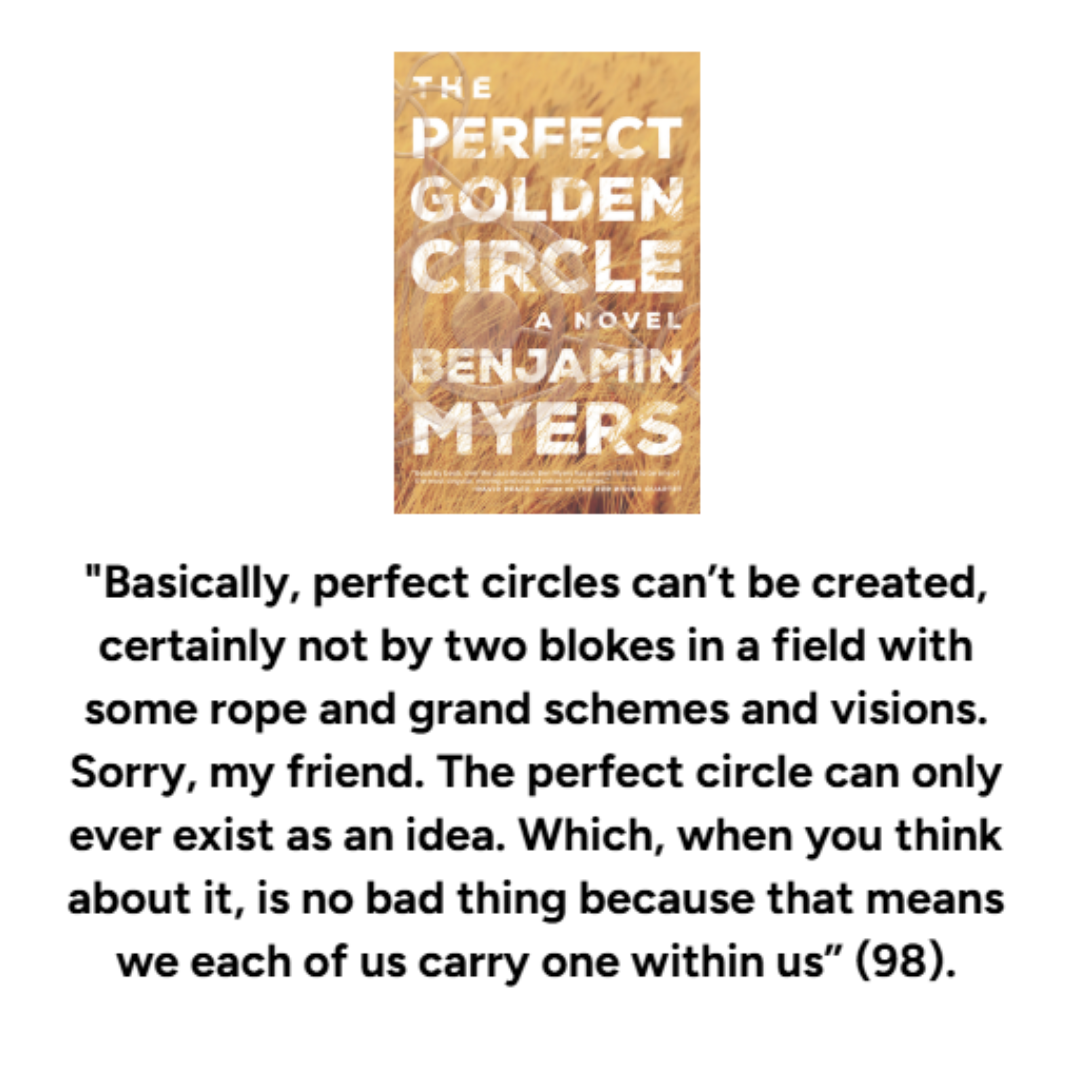You Should Read THE PERFECT GOLDEN CIRCLE by Benjamin Meyers
Reading Notes
Last week, before school started on Tuesday, I asked my AP students to bring in a sentence or two from their summer novel that moved, inspired, or challenged them. In my email I included my own selection from The Perfect Golden Circle by Benjamin Meyers: “Basically, perfect circles can’t be created, certainly not by two blokes in a field with some rope and grand schemes and visions. Sorry, my friend. The perfect circle can only ever exist as an idea. Which, when you think about it, is no bad thing because that means we each of us carry one within us” (98). I provided no context but promised to explain what I loved about the passage when I met my students on the first day of school.
A quote from a novel about two men crisscrossing southern England in 1989 to make crop circles by night? Yeah, I hear you: It seems like an odd “Welcome Back to School” choice. I’m supposed to be helping my seniors with college essays right now, not encouraging them to get sucked into conspiracy theories or to start a hoax themselves.
Then again, we know novels are never just plots. The Perfect Golden Circle is about the repercussions of trauma; the intersection of politics and art; the search for meaning from outside mainstream culture; the inescapable human drive for creative expression.
It’s a novel about characters who question existing power structures and who want to get people’s attention. If that doesn’t speak to being seventeen and starting your last year in high school—your last year before leaving home and figuring yourself out—well, I don’t know what does.
Redbone and Calvert are two men on a mission. Redbone is the dreamy creative type, whose “mind is cluttered with recollections of rhapsodic birdsong and paintings he has done and rivers he has swum” (8). He lives where he pleases, traveling across the country in his van. Calvert, on the other hand, is a veteran of the Falklands War “whose natural pace in all areas of his life is a strident and purposeful march” (8). The two meet up in the back of a pub to plan their nighttime outings. Redbone creates the designs, each more elaborate than the next, while Calvert handles reconnaissance and logistics. Their crop circles dot the English countryside, drawing attention from alien hunters and news reporters alike.
I haven’t seen crop circles, but I did see the ancient pyramids in Teotihuacán last month, and they seemed as full of mystery and creativity as crop circles do in the novel.
While the pair enjoy watching the public make a fuss over the crop circles, fame is not their goal. They take no credit for their work and follow a simple mantra: Fuel the myth. Strive for beauty. Why go through all this work for no reward? As Calvert explains, “[T]his isn’t about the patterns or the crops, it’s about the land. The land. It’s about getting people to learn to love it so that they don’t take it for granted, and then feel compelled to protect it” (173).
Which brings me back to my first-day-of-school quote: “[P]erfect circles can’t be created.” Teenagers deal with so much pressure today. Sure, I remember being a senior in high school and stressing over college applications. I wrote and rewrote my college essay, and I wondered what I’d do with the rest of my life, same as my students. But I never felt the obligation to save the planet. Multiple studies in the last four years report increasingly negative effects of climate disasters on teenage mental health, and no wonder. It’s bad enough, waiting to hear back from your dream college, but waiting while the planet burns may feel impossible or—worse—pointless. A perfect solution, like a perfect circle, can’t be created.
And yet, just because it can’t be created doesn’t mean we stop trying. Calvert and Redbone can’t flatten fields into geometrically perfect shapes, but the public doesn’t care. It’s not the precision of the shape that matters as much as the mystery of it and the intention behind it.
Remember: “[W]e each of us carry [a perfect circle] within us.” A circle could be an idea or a vision or a desire. Your circle no doubt differs from mine. But regardless of what your circle is, it’s connected to mine because we are both human. That perfect golden circle within you is your passion for what makes you you. What I want my students to know is that they might be worried about being the perfect candidate on a college application, but it’s not the perfection of their “circle” that appeals to admissions officers; it’s the humanity of it.
I hope a few of my students find their way to The Perfect Golden Circle. You should read it, too.
Need-to-Know
Pub Date: 2022
Length: 206 pages; audiobook runs 5 hours 37 minutes
Timeline: Southern England, summer of 1989
Narrator: Close third POV of Calvert and Redbone
Pairs Well With: Ghost Wall by Sarah Moss; listening to classical music on the radio; drinking pints at the pub
Book Club
Although Redbone and Calvert are both social misfits, they are opposites in many ways: “Where Redbone sees life as a thrilling continuum, Calvert considers it a conundrum that can never be solved, only endured” (111). Which character do you most identify with? Which character’s worldview feels most authentic to your experience?
In this book, we only get hear-say and news reports of people’s reactions to the crop circles. Imagine you stumble across a huge, beautiful design in the middle of a field. How would you react? Have you ever encountered something unexplainable in a natural setting? How did it make you feel?
Close Reading
At the beginning of the book, Meyers describes Calvert as a man “whose natural pace in all areas of his life is a strident and purposeful march” (8). This characterization casts him as someone who wants to be in constant motion, who is driven by a deep inner desire to move forward. “March” holds a military connotation, which fits our understanding of Calvert as a veteran. He is the consummate man of action—at first.
Toward the end of the book, we see Calvert at home in his tiny house, agitated and anxious, with a “mind [that] feels like a furnace.” The only way to alleviate his worries is to focus on the crop circles: “[H]e thinks of the next one, and the next one and the one after that, as a means to avoid his mind turning to past traumas that stalk his every waking moment” (153). Calvert’s “purposeful march” is revealed to be an attempt to escape his past, rather than a determined optimism for the future. Memories “stalk” him like a predator stalks prey. The connotation of a hunter embedded in “stalk” undercuts the militaristic power of Calvert’s earlier “march” and renders his character with more nuance and humanity.
Creative Writing
Fiction: Meyers sections this book by crop circle locations rather than by chapter. At the close of each section is an artifact, like a newspaper article, from the public that is reacting to the latest creation. Mine the historical records for articles about crop circles (or other urban myths or legends). Borrow the juiciest headline for your first sentence. Who is reacting to the phenomenon? Are they true believers, or are they skeptical? Either way, what drives their position on the strange occurrence? You can discover a lot about a character by how they react to unusual situations.
Nonfiction: Redbone and Calvert live by their own self-made motto: Fuel the myth and strive for beauty. What’s your motto? Start with two strong verbs, like “fuel” and “strive.” Then, build three-word sentences, like the characters’ motto. Once you’ve got a simplified motto, spend some time reflecting on (and writing about) what it means to you.
Sentence Study
It begins to rain just as Redbone and Calvert arrive at their location. As they wait in the van, they witness a powerful thunderstorm:
“Purple lightning strikes a pitchfork fracture with violent precision in the evening sky. Abrupt, jagged.”
This sentence has it all!
Alliteration ties everything together: purple, pitchfork, precision. The repeated “p” sound is like a thread holding pieces of cloth together; every time we hear the “p,” it’s like the thread is being pulled above the cloth before the needle dives to the other side for a few more words. The imagery of the “pitchfork fracture” is spot-on. This isn’t just sheet lightning hanging in the clouds. It’s a comic-book style thunderbolt directed right at the earth. The image is as precise as the lightning’s own “violent precision.” With that choice of words, Meyers conjures Calvert’s troubled past in the Falklands.
Then, just as this wonderful sentence ends, Meyers adds a fragment to top it off: “Abrupt, jagged.” Just like a bolt of lightning. Perfection.


